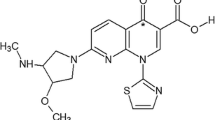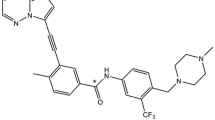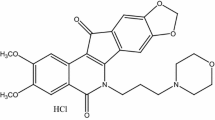Abstract
NK611 is a novel water-soluble podophyllotoxin derivative that has comparable antitumour activity but higher potency and better bioavailability in animals as compared with etoposide. The primary objectives of this study were to determine, after both oral and intravenous administration in the same patient, the bioavailability and the pharmacokinetic profile of NK611. Secondary objectives involved evaluation of the toxicity and the antitumor activity. Patients were randomly assigned to receive oral or intravenous (30-min infusion) doses of 5, 10, and 20 mg/m2 on day 1, when pharmacokinetic studies were performed. A daily oral dose of 20 mg/m2 was then given from day 4 through day 7 for respective total doses of 85, 90, and 100 mg/m2. NK611 and its metabolites were determined in plasma and urine by two different high-performance liquid chromatography (HPLC) methods with UV detection. A total of 21 adult patients entered the study and received the complete first cycle and at least the 1st day of cycle 2; 17 of them received at least 2 complete cycles of treatment. After intravenous administration, the plasma decay curve of NK611 followed a two-exponential model, and after oral administration it declined monoexponentially in most cases. At all dose levels, bioavailability values were around 100%. At concentrations between 10 and 20 mg/m2 after both routes of administration, the pharmacokinetics were nonlinear; the terminal half-life, plasma clearance, and volume of distribution were significantly different; and the area under the plasma concentration-time curve was not correlated to the dose. The urinary excretion of NK611 corresponded to 10–15% of the dose after administration by both routes, whereas that of N-demethyl NK611 and its picroform was highly variable. The features of neutropenia were comparable with those noted for etoposide involving a high degree of interpatient variability and recovery within 1 month after treatment. A daily dose of 20 mg/m2 for 5 consecutive days every 4 weeks is the recommended regimen for phase II studies in patients who have never been treated or have undergone previous chemotherapy only once.
Similar content being viewed by others
Author information
Authors and Affiliations
Additional information
Received: 26 November 1995: Accepted: 27 March 1996
Rights and permissions
About this article
Cite this article
Pagani, O., Zucchetti, M., Sessa, C. et al. Clinical and pharmacokinetic study of oral NK611, a new podophyllotoxin derivative. Cancer Chemother Pharmacol 38, 541–547 (1996). https://doi.org/10.1007/s002800050524
Issue Date:
DOI: https://doi.org/10.1007/s002800050524




